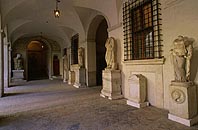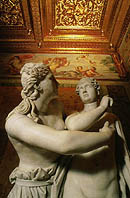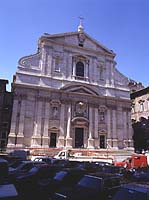Palazzo Altemps
This beautifully restored Renaissance palace is a delight to visit since it presents an important collection of ancient Roman statuary in a lovely setting.
Here, and at the Museum of Villa Borghese, you can see what leading Sixteenth and Seventeenth Century families collected as their contribution to the Renaissance - literally the "re-birth" of classical culture.
Palazzo Altemps History HistoryIn ancient times this served as a marble warehouse, near the Temple of Apollo. 1477. This building was started by Girolamo Riario. (The Riario family, with Pietro who started Palazzo Corsini, and Raffaele who built the Cancelleria - cousins and nephews to Pope Sixtus IV della Rovere - brought nepotism to new heights). 1511-23. Cardinal di Volterra Francesco Soderini added refinements. 1568. The reluctant Cardinal Marco Sittico Altemps finished the building as a fitting place to show off his magnificent collections of books and of antique sculpture. This great connoisseur became a Cardinal despite strong inclinations in other directions (he had a son, Roberto, to prove it). In aristocratic European families in those days, the first son inherited the family castle, the next became a military officer, and the third went into the Church. They had no choice. |
Museum of Altemps Palace
Many pieces are gone from Cardinal Altemps' original collection, scattered in museums around the world.
The remaining Altemps pieces are enhanced with sculptures from the Ludovisi and Egyptian Collections from the Museo Nazionale Romano, and these other works serve to fill the palazzo.
The sculptures are clearly identified by their name tags, and many have drawings next to them showing how the statue had been broken in the past, and which part was restored. Most of the statues are larger-than-life and very imposing.
The Courtyard (Sangallo, Peruzzi, and Longhi). One is immediately struck by the discreet elliptical awning (something like what must have been over the Colosseum), which protects the patio and adds a luminous quality to the old stone, marble and colorful frescoes.
In the center of one wall is a mosaic fountain made mostly of sea shells. The panel of miniature cockle shells and pebbles shows an art form that defies patience. Don't miss the Altemps coat of arms (lightning hitting a bridge) in colored sand and lime.
Ground Floor
The arcading is perfectly proportioned for the statuary.
Hall of the Portraits. Among the busts of Emperors, "Julius Caesar", the action man, looks mousy and "Marcus Aurelius", the philosopher, looks mighty.
Hall of the Tower. You can see parts of the ancient Roman houses on which the Palazzo's foundations reside.
Hall of the Entrance to Palazzo Riario. "Aphrodite", just out of her bath, looks beautiful and vulnerable.
Halls of Athena. In both statues the goddess looks unbeautiful and invulnerable.
 Upstairs
Upstairs
South Loggia. Don't miss the first bas-relief on the left wall, dating from 2C AD. It shows several Gods and Goddesses at play on Mt. Olympus. Vulcan, having just caught Mars "in flagrante" with his wife Venus, gathers Apollo, Hercules, Bacchus, Mercury, Mars and Luna as witnesses.
The two first rooms house the Egyptian and Syrian pieces; the bull in striated marble has a nobility about it. In the next small room a famous Greek statue of a satyr used to stand on a street in ancient Athens, and was copied all around the ancient world. Note the ribbon holding the pipes of Pan - it is so fine it seems to move in the wind.
Room of the Painted Views. A sunny corner room, has frescoes all over the walls and up to the ceiling. Columns with "trompe l'oeil" tapestries of landscapes give a richness, and the views are stunning.
Above these is a painted balcony, just under the ceiling, stuffed with jolly fat cherubs.
"Hermes Longhios" is a beautiful white marble work of art. A bit of red in his hair shows that in ancient times it was gilded.
Room of the Sideboard. Has a dark fresco showing some furniture groaning with silver platters; it is masterly.
In 1477 Girolamo Riario and Caterina Sforza were married, some believe in this room, and originally on all four walls were paintings of the wedding presents and greeting cards.
Room of Moses. Has a frieze of the story of Moses high up on the walls.
Here is a most famous sculpture of antiquity, the. "Ludovisi Throne", 5BC. A relief sculpture of Aphrodite being born out of the waves, helped by two handmaidens. Her transparent dress is clinging to her body in wet folds leaving little to the imagination.
Dug up from the Ludovisi gardens at the end of the last century, the sculpture has a fascinating past. First, the Mythology: Cronus cut off his father Uranos' testicles with a diamond, and threw them into the sea. Thus Aphrodite Urania is born from his sperm/foam.
In early Roman times this beautiful bas-relief had already been pinched from its holy temple setting in Magna Grecia, from the city of Epizephiris (Gentle Breezes in Ancient Greek).
Julius Caesar sequestered the carving and put it in his gardens here (he had many other gardens, though never got to enjoy them much).
Then came the Long Sleep, until it was discovered 100 years ago.
Room the Cardinal's Bedchamber. Frescoes here are vivid, and the wooden ceiling charmingly painted. The large red marble flat sculpture of "Dionysius" with round holes for eye and mouth makes one wonder if wine flowed instead of water from this fountain.
Under the sculpture and to the right is a little cupboard. This was used by the Cardinal as a "convenience for urinating".
Room of the Fireplace. A gigantic fireplace dominates this room which used to go up two stories (the present ceiling is modern).
Also dominating the room is a giant statue of "Galata's Suicide", showing realistic marble drops of blood where he is plunging his sword into himself.
On the right is an enormous sarcophagus, 3C. It is carved from a single piece of marble. Romans battle Barbarians all over the place. Particularly fine renditions of a Roman General's skirt which seems to be flying (center); a coat of mail on a Roman soldier (right corner), and all the horses' faces - frightened and neighing - make this an exciting work of art.
The private Chapel is in stark contrast to the ornate Church of Sant'Aniceto room, which is richly frescoed and marbled.
Don't miss some more cherubs having a fine old time on the ceiling.
Altemps was bitterly grieved by Pope Sixtus V killing his son Roberto as an example to the other rowdies, and perhaps named his chapel, in a defiant mood, after an unknown Pope who wasn't a saint (Anicetus c 155-66).
![]() Our favorite: the Northern Loggia. Facing due south and drenched in sun, this charming space is rich in scrumptious frescoes of pergolas and climbing plants.
Our favorite: the Northern Loggia. Facing due south and drenched in sun, this charming space is rich in scrumptious frescoes of pergolas and climbing plants.
Here were placed the obligatory busts of the 12 Caesars (that every self-respecting connoisseur should have).
The small fountain has glass mosaics, cupids, 2 Altemps rams, and 2 girls with water urns.
Open Tuesday through Sunday 9 am-7 pm Closed Monday
S. Lorenzo in Damaso
This Basilica is situated inside Palazzo della Cancelleria, the first large palazzo in Rome built entirely in the new Renaissance style that had been nurtured by the Medici family in Florence. (Palazzo Venezia was built earlier, but is not 100% Renaissance).
This gleaming white palace is made of travertine, much of which was stripped from the nearby Theater of Pompey, as were also all the great columns in the vast inner courtyard.
| St. Lorenzo in Damaso History Roman Epoque. Underneath this palace lies a tomb and (yet another) temple of Mithras 366-384 AD. Pope St. Damasus built, and gave his name to the church and public library here. 1486. Cardinal Raffaele Riario, Pope Sixtus IV della Rovere's nephew, built this vast pile thanks to the gains from one night's gambling with another pope's nephew. It included his titular Church, rebuilt and dedicated as San Lorenzo in Damaso - the entrance is on the right side of the facade. 1513. The Palace was finished just in time for the installation of the first Medici Pope, Leo X, who proceeded to seize it from the owners, punishing them for their part in the bloody assassination plot against the Medici elders. 1798. The church was a stable during France's occupation of Rome and was completely restored in the 19 C. Since Riario was Vice Chancellor to his powerful uncle, his palace is the Cancelleria (Chancellery). In fact, after various other uses over the centuries, including the Rome residence of a Cardinal-Duke, the brother of Scotland's Bonnie Prince Charlie, it now houses the Papal Chancellery - and is an exclave of the Vatican, not subject to Italian sovereignty. |
Corso Vittorio Emanuele II corner with Piazza della Cancelleria (Map E 5)
Church of Gesù
 (1568-84, Vignola and Della Porta).This is the mother church of the Jesuit Order and architecturally represents a step in the transition from Renaissance sobriety to Baroque excess.
(1568-84, Vignola and Della Porta).This is the mother church of the Jesuit Order and architecturally represents a step in the transition from Renaissance sobriety to Baroque excess.
The Jesuits, as much militant as spiritual, wanted a church in keeping with the anti-Protestant decisions of the Council of Trent. Under the politically astute Pope Pius IV, the Council favored reforming the Church in order to negate the accusations of the Protestants and to satisfy the laymen's need for personal attention from the clergy.
This church satisfied all the requirements of the Council of Trent since its broad nave accommodates the hoards of faithful being preached to: there is a clear separation between the congregation and the priests, and the main altar's central position is emphasized as the spot where the laity receive the mass from the clergy.
Della Porta's Facade, along with Vignola's rejected plan, is probably the most widely copied of all church designs since Gothic times.
Those heavy lateral scrolls embracing Greek columns solve the problem posed for designers of church facades, by the fact that the center nave is much higher than the two side aisles. This became the model, often called "Jesuit Style", for Baroque churches all over the world.
Contrasting with this external sobriety is the later, and overly ornate, high Baroque interior.
Don't miss the Capella di San Ignacio (in the transept on the left) where the saint is buried under the altar, his sleek silver statue surrounded by dazzling lapis lazuli columns
Bernini did the furiously praying St. Robert Bellarmino statue on the left in the choir.
| Church of Gesù History 1540. With the approval of Pope Paul III Farnese, a Spanish soldier called Ignatius Loyola (canonized in 1622) founded the Society of Jesus devoted to zealous missionary and preaching activity. 1545. Paul III, a great Renaissance humanist, sought to promote Christian unity and reform the Church by calling a General Council which convened in Trent. 1552. Pope Julius III Ciocchi del Monte, a pleasure-loving indolent pontiff, had to suspend the Council meetings due to hostility between the Austrian Holy Roman Emperor and the King of France. 1564. Pope Pius IV Medici (no relation) concluded the Council of Trent with reformist policies designed to fight Protestantism, including ordering bishops to leave Rome and work in their diocese. He reined in the Inquisition and curtailed the Index of Forbidden Books, but finessed Emperor Ferdinand's demand that priests be allowed to marry, as they had in the early years of Christianity. |
St. Maria in Campitelli
In 1658 when the devastating plague abated, Pope Alexander VII planned this Baroque church to house (in the ornate altar tabernacle) an ancient icon of the Virgin to which the Romans had fervently prayed for the pestilence to end.
The facade and especially the interior designed by Carlo Rainaldi are forests of giant columns, perhaps representing the importance of supporting Christianity.
Palazzo Doria Pamphili
 The facade across the street from the gallery entrance of Palazzo Venezia, is one side of the immense home still belonging to the Doria Pamphili family.
The facade across the street from the gallery entrance of Palazzo Venezia, is one side of the immense home still belonging to the Doria Pamphili family.
Walk straight ahead, down Via Gatto (keeping the Palazzo's long 19C facade on your right), into Piazza Collegio Romano and to your right is the elegant 17C L-shaped entrance to this grandiose building (Antonio del Grande 1660).
The palazzo is a potpourri of noble owners: Pope Julius II della Rovere gave it to his nephew the Duke of Urbino, whose descendants sold it to Cardinal Pietro Aldobrandini, whose heir Donna Olimpia married Innocent X's nephew Camillo Pamphili, on the death of whose brother it passed to the princely Doria family.
From this entrance you can glimpse the large inner garden and reach the important family art collection (see: Museums).